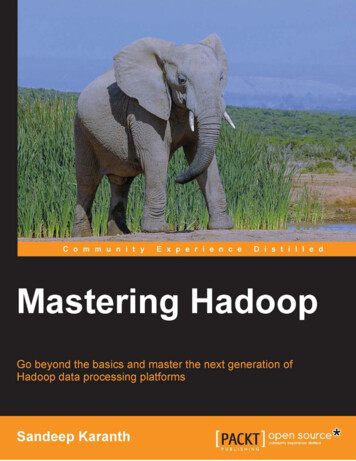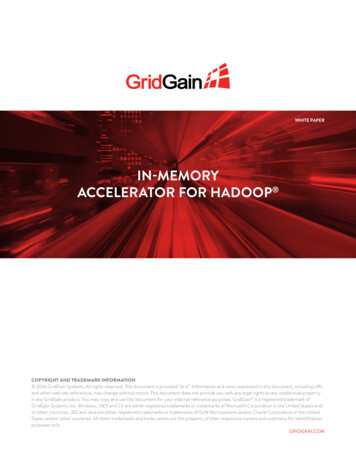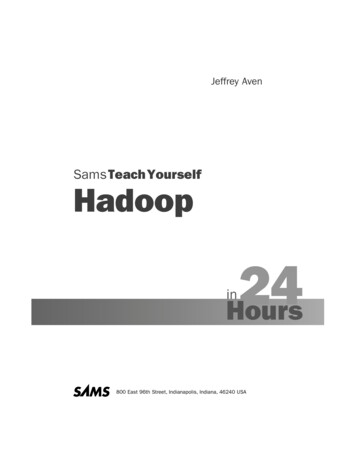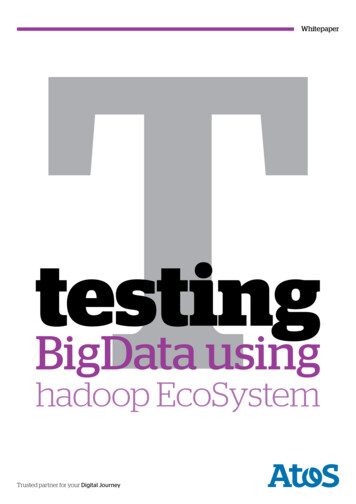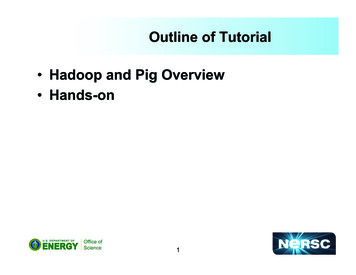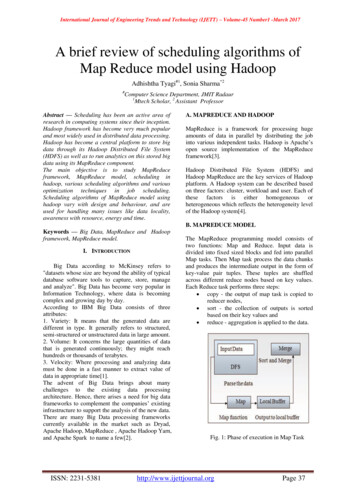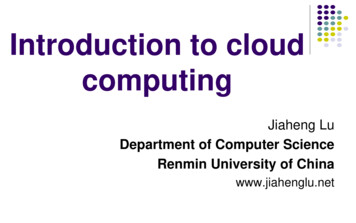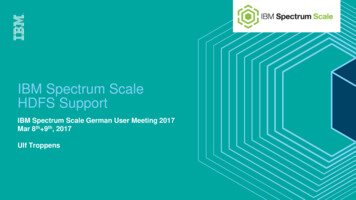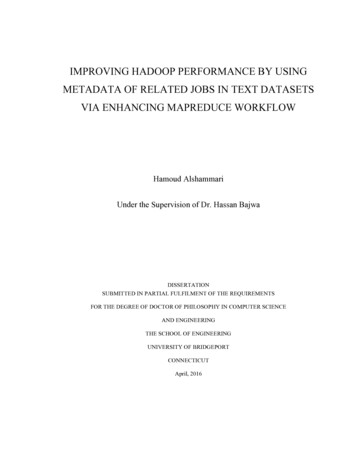
Transcription
IMPROVING HADOOP PERFORMANCE BY USINGMETADATA OF RELATED JOBS IN TEXT DATASETSVIA ENHANCING MAPREDUCE WORKFLOWHamoud AlshammariUnder the Supervision of Dr. Hassan BajwaDISSERTATIONSUBMITTED IN PARTIAL FULFILMENT OF THE REQUIREMENTSFOR THE DEGREE OF DOCTOR OF PHILOSOPHY IN COMPUTER SCIENCEAND ENGINEERINGTHE SCHOOL OF ENGINEERINGUNIVERSITY OF BRIDGEPORTCONNECTICUTApril, 2016
IMPROVING HADOOP PERFORMANCE BY USINGMETADATA OF RELATED JOBS IN TEXT DATASETSVIA ENHANCING MAPREDUCE WORKFLOWHamoud AlshammariCommittee MembersNameSignatureDateDr. Hassan BajwaDr. JeongKyu LeeDr. Navarun GuptaDr. Miad FaezipourDr. Xingguo XiongDr. Adrian RusuPh.D. Program CoordinatorDr. Khaled M. ElleithyChairman, Computer Science and Engineering DepartmentDr. Ausif MahmoodDean, School of EngineeringDr. Tarek M. Sobhii
IMPROVING HADOOP PERFORMANCE BY USINGMETADATA OF RELATED JOBS IN TEXT DATASETSVIA ENHANCING MAPREDUCE WORKFLOW Copyright by Hamoud Alshammari 2016iii
IMPROVING HADOOP PERFORMANCE BY USINGMETADATA OF RELATED JOBS IN TEXT DATASETSVIA ENHANCING MAPREDUCE WORKFLOWABSTRACTCloud Computing provides different services to the users with regard toprocessing data. One of the main concepts in Cloud Computing is BigData and BigDataanalysis. BigData is a complex, un-structured or very large size of data. Hadoop is a toolor an environment that is used to process BigData in parallel processing mode. The ideabehind Hadoop is, rather than send data to the servers to process. Hadoop divides a jobinto small tasks and sends them to servers. These servers contain data, process the tasksand send the results back to the master node in Hadoop.Hadoop contains some limitations that could be developed to have a higherperformance in executing jobs. These limitations are mostly because of data locality inthe cluster, jobs and tasks scheduling, CPU execution time, or resource allocations inHadoop.Data locality and efficient resource allocation remains a challenge in cloudcomputing MapReduce platform. We propose an enhanced Hadoop architecture thativ
reduces the computation cost associated with BigData analysis. At the same time, theproposed architecture addresses the issue of resource allocation in native Hadoop.The proposed architecture provides an efficient distributed clustering approach fordedicated cloud computing environments. Enhanced Hadoop architecture leverages onNameNode’s ability to assign jobs to the TaskTrakers (DataNodes) within the cluster. Byadding controlling features to the NameNode, it can intelligently direct and assign tasksto the DataNodes that contain the required data.Our focus is on extracting features and building a metadata table that carriesinformation about the existence and the location of the data blocks in the cluster. Thisenables NameNode to direct the jobs to specific DataNodes without going through thewhole data sets in the cluster. It should be noted that newly build lookup table is anaddition to the metadata table that already exists in the native Hadoop. Our developmentis about processing real text in text data sets that might be readable such as books, or notreadable such as DNA data sets. To test the performance of proposed architecture, weperform DNA sequence matching and alignment of various short genome sequences.Comparing with native Hadoop, proposed Hadoop reduced CPU time, number of readoperations, input data size, and another different factors.v
ACKNOWLEDGEMENTSIn the name of Allah most gracious most merciful, I thank him for everything I doand everyone he has allowed me to have in my life to help me in achieving my doctoraldegree. I would like to start with my academic mentor Dr. Hassan Bajwa. I am gratefulfor his endless support; his guidance and leadership are qualities of true leader in thefield. The commitment and dedication he provides to his advisees inspires me to be aleader in the field. His support has allowed me to reach this point and for that thank you.Also, I would like to thank my Co-advisor Dr. Jeongkyu Lee for his supportduring my classes and research. A special appreciation goes to Dr. Khaled Elleithy for hissupport and direction during my study. To all my committee members, thank you foryour points and directions that I have received from you to develop my work.To my mother, I ask Allah to save you, give you the strength, and to live healthyduring the rest of your life. I appreciate your patience and support during all of my life.To my wife and my kids Sari and Mariam I love you and ask Allah to save you and saveour family. To my brothers, sisters, and friends I appreciate your support at all times andI wish you all the best in your lives.vi
TABLE OF CONTENTSABSTRACT . ivACKNOWLEDGEMENTS . viTABLE OF CONTENTS . viiLIST OF TABLES . xLIST OF FIGURES . xiCHAPTER 1: INTRODUCTION . 11.1What is BigData? . 11.2What are Hadoop and MapReduce? . 21.3What is MapReduce Job? . 41.4Comparison of Hadoop with Relational Database Management Systems –RDBMS. 81.5Hadoop for Bioinformatics Data . 91.6Research Problem and Scope. 91.7Motivation behind the Research . 111.8Potential Contributions of the Proposed Research . 12CHAPTER 2: LITERATURE SURVEY. 132.1 Optimizing Job Execution and Job Scheduling Processes . 142.1.1 Optimizing Job Execution Process . 14vii
2.1.2 Optimizing Jobs Scheduling Process . 172.1.3 Optimizing Hadoop Memory and Cashing Data Control . 202.2 Improving Data considerations in Cloud Computing . 242.2.1 Improving performance Based on Data Type . 242.2.2 Improving performance Based on Data Size . 272.2.3 Improving performance Based on Data Location . 292.3 Optimizing Cloud Computing Environment . 352.4 Drawback of some solutions . 40CHAPTER 3: RESEARCH PLAN . 413.1 Overview of Native Hadoop Architecture . 413.1.1 Native Hadoop MapReduce Workflow . 423.1.2 Overview of native Hadoop Performance. 453.1.3 Hadoop MapReduce Limitations . 483.2 Proposed Enhanced Hadoop Architecture . 483.2.1 Common Job Blocks Table (CJBT) . 493.2.2 End-User Interface . 533.2.3 Enhanced Hadoop MapReduce Workflow . 53CHAPTER 4: IMPLEMENTATION AND TEST PLAN . 574.1 Creating the Common Job Block Table (CJBT) . 584.2 Designing User Interface (UI) . 584.3 Proposed Solution Environment . 584.4 Execute some experiments on the enhanced Hadoop . 59viii
4.5 Amazon Elastic MapReduce EMR experiments. 60CHAPTER 5: RESULTS . 615.1Comparing Native Hadoop with Enhanced Hadoop . 615.1.1 HDFS: Number of Read Operations . 625.1.2 CPU Processing Time . 635.2Comparing Amazon EMR with Enhanced Hadoop. 665.2.1 Number of Read Operations Form HDFS and S3 . 665.2.2 CPU Processing Time . 675.2.3 Number of Bytes Read . 68CHAPTER 6: CONCLUSIONS . 70REFERENCES . 73APPENDIX A: PUBLICATIONS . 83ix
LIST OF TABLESTable 2.1Improving in Job Scheduling, Execution Time, and Cashing Data23Table 2.2Improving in Data Considerations in Cloud Computing34Table 2.3Improving in Cloud Computing Environment39Table 3.1Common Job Blocks Table components50Table 3.2Likelihood of Random Nucleotides52Table 4.1Common Job Block Table (DNA example)59Table 5.1A List of Factors that we can use to Compare Between NativeHadoop and H2Hadoop for Sequence2 Resultsx65
LIST OF FIGURESFigure 1.1Overall MapReduce WordCount MapReduce Job5Figure 1.2Native Hadoop Architecture6Figure 1.3DataNodes and Task Assignment7Figure 2.1Execution time of wordcount benchmark in SHadoop and thestandard Hadoop with different node numbersFigure 2.2Comparing in Execution time using Push-model between(a) Standard Hadoop and (b) Proposed Hadoop in Map phaseFigure 2.316Comparing in Execution time using Push-model between(a) Standard Hadoop and (b) Proposed Hadoop in Reduce phaseFigure 2.41516Comparison of runtime (in hours) of the jobs between Capacityand machine learning based algorithms19Figure 2.5Cash system in Unbinding-Hadoop22Figure 2.6New Hadoop Archive techniques that is presented in NHAR28Figure 2.7Architecture of combining multiple small files into one large file28Figure 2.8Number of Read Operations in Native and Proposed Hadoop29Figure 2.9Map and Reduce-input heavy workload31Figure 2.10 Mean and range of the job processing times by repeating 5 times32Figure 2.11 Map and Reduce execution time of WordCount example33Figure 2.12 EC2 Sort running times in heterogeneous cluster36xi
Figure 3.1Native Hadoop MapReduce Architecture44Figure 3.2Native Hadoop MapReduce Workflow Flowchart45Figure 3.3Enhanced Hadoop MapReduce Architecture54Figure 3.4Enhanced Hadoop MapReduce Workflow Flowchart56Figure 5.1Number of read operations in Native Hadoop and EnhancedHadoop for the same jobFigure 5.262CPU processing time in Native Hadoop and Enhanced Hadoopfor the same jobsFigure 5.363Number of read operations in Amazon EMR and Enhanced Hadoopfor the same jobsFigure 5.466CPU processing time in Amazon EMR and Enhanced Hadoopfor the same jobsFigure 5.568Number of Bytes Read in GB in Amazon EMR and Enhanced Hadoopfor the same jobs69xii
CHAPTER 1: INTRODUCTIONHuman Genome Project is arguably the most important scientific project that hasproduced the most valuable dataset scientific community has ever seen. Translating thedata to meaningful information requires substantial computational power and efficientalgorithms to identifying the degree of similarities among multiple sequences [1].Sequential data applications such as DNA sequence aligning usually require large andcomplex amounts of data processing and computational capabilities [2]. Efficientlytargeting and scheduling of computational resources is also required to such complexproblems [3]. Although, some of these data are readable by humane, it can be verycomplex to be understood and processed using the traditional techniques [3, 4].Availability of open source and commercial cloud computing parallel processingplatforms have opened new avenues to explore structured, semi-structured orunstructured genomic data [5]. Before we go any further, it is necessary to define certaindefinitions that are related to BigData, Hadoop and MapReduce.1.1 What is BigData?It is either relational database (Structured) such as stock market data or nonrelational database (Semi-structured or Unstructured) such as social media data or DNAdata sets. Usually, very large in size, BigData cannot be processed using traditional1
processing techniques such as Relational Database Management Systems -RDBMS [6].A survey that has been done explaining different studies that are exploring some issues inBigData, and it explains the 4V model of BigData.4V’s of BigData are 1) Volume of the data, which means the data size, and we aretalking about zetabyte these days. 2) Velocity, which means the speed of the data orstreaming of the data. 3) Varity of the data, which means the data forms that differentapplications deal with such as sequence data, numeric data or binary data. 4) Veracity ofthe data, which means the uncertainty of the status of the data or how clear is the data tothese applications [7].Different challenges in BigData have been discussed in [8] and they are describedas a technical challenges such as the physical storage that stores the BigData and reducethe redundancy. Also, the process of extracting the information, the cleaning the data isone challenge, data integration, data aggregation and representation.1.2 What are Hadoop and MapReduce?Hadoop is an Apache open-source software framework that is written in Java fordistributed storage and distributed processing. It provides solutions for BigDataprocessing and analysis. It has a file system that provides an interface between the users’applications and the local file system, which is the Hadoop Distributed File SystemHDFS. Hadoop distributed File System assures reliable sharing of the resources forefficient data analysis [9].2
The two main components of Hadoop are: (i) Hadoop Distributed File System(HDFS) that provides the data reliability (distributed storage) and (ii) the MapReduce thatprovides the system analysis (distributed processing) [9, 10]. Relying on the principle that“moving computation towards data is cheaper than moving data towards computation”[11], Hadoop employs HDFS to store large data files across the cluster. There are severalreasons that make companies use Hadoop, some of them are it is an open source and canbe run on commodity hardware, the initial cost savings are dramatic and continue to growas your organizational data grows, and it has a robust Apache community behind it thatcontinues to contribute to its advancement.MapReduce provides stream reading access and runs tasks on a cluster of nodesand provides a data managing system for a distributed data storage system [12].MapReduce algorithm has been used for applications such as generating search indexes,document clustering, access log analysis, and different other kinds of data analysis [13].“Write-once and read-many” approach permits data files to be written only oncein HDFS and then allows it to be read many times over with respect to the numbers ofjobs [9]. During the writing process, Hadoop divides the data into blocks with apredefined block size. The blocks are then written and duplicated in the HDFS. Theblocks can be duplicated a number of times based on a specific value which is 3 times bydefault [14].In HDFS, the cluster that Hadoop is installed in is divided into two maincomponents, which are (i) the master node called NameNode and (ii) the slaves calledDataNodes. In Hadoop cluster single NameNode is responsible for overall management3
of the files system including saving the data and directing the jobs to the appropriateDataNodes that store related application data [15]. DataNodes facilitates HadoopMapReduce to process the jobs with streaming execution in a parallel processingenvironment [9, 16].Running on the master node, JobTracker coordinates and deploys the applicationsto the DataNodes with TaskTracker services for execution and parallel processing [14].Each task is executed in an available slot in a worker node, which is configured with afixed number of map slots, and another fixed number of reduced slots. The input toMapReduce is in text format, so the data must be read as text files, and the output also isin text file format [9].1.3 What is MapReduce Job?A MapReduce job is an access and process-streaming job that splits the inputdataset into independent chunks (blocks) and stores them in HDFS. It has two main tasksMap and Reduce, which are completely in parallel manner. Storing data in HDFS hasmany forms, one of them is a Key, Value concept to determine the given parameterand retrieve the required result as a value in the end of the whole job.Figure 1.1 explains MapReduce example of wordcount as a common example toapply MapReduce in such unstructured data like books. As input file, it consists ofsequence of strings that are separated by space, so we can consider the space as adelimiter that separate words.4
Figure 1.1: Overall MapReduce WordCount MapReduceJob.First step, Hadoop divides the data to blocks (Splitting phase). Then, Mappingphase dose key, value for each word (e.g. Deer, 1 . Then, Shuffling phase collectsthe values of the same key to be in one intermediate result. After that, Reducing phasedoes the addition of the values to have one final value for each key. Finally, NameNodeprovides a final result that has all keys and their values as a one final result from theMapReduce job.HDFS cluster is composed of a centralized indexing system called NameNodeand its data processing units called DataNodes; together they form a unique distributedfile system. NameNode plays an important role in supporting the Hadoop Distributed FileSystem by maintaining a File-Based block index map; this map is responsible for locatingall the blocks related to the HDFS. HDFS is the primary storage system. It createsmultiple replicas of data blocks and is further responsible for distributing data blocksthroughout a cluster to enable reliable and extremely rapid computations [17]. Figure 1.25
shows the native Hadoop architecture that gives an overview on Cloud Computingarchitecture too.Column Oriented Hbase ClusterCloud InfrastructureZookeeper DistributedCoordination ServiceRouterCloudlFolowerLead2z1Broad Band ModemerZnodes 1Switch/Firewall3z24z3RouterCloudKcube NameNodeDataNode 1Hb12KcubeSecondarynode43Hb2Hb3Router567HDFS8Hbase column oriented ServersZnode Coordination ServersFigure 1.2: Native Hadoop Architecture.ZooKeeper is critical component of the infrastructure, it provides coordinationand messaging across applications [18]. The ZooKeeper capabilities include naming,distributing synchronization, and group services. Hadoop framework leverages on largescale data analysis by allocating data-blocks among distributed DataNodes.Hadoop Distributed File System shown in Figures 1.2 and 1.3 allows thedistribution of the data set into many machines across the network that can be logicallyprepared for processing. HDFS adopted “Write-Once and Read-Many” model to storedata in distributed DataNodes. NameNode is responsible for maintaining namespacehierarchy, managing data blocks and DataNodes mapping [19]. Once job information is6
received from the client, NameNode provides a list of available data nodes for the job.NameNode maintains the list of available data nodes and is responsible for updating theindex list when a DataNode is unavailable due to failure in hardware or network issues. Aheartbeat is maintained between the NameNode and the DataNodes to check the keepalive status and health of the HDFS [20]. Client writes data directly to the DataNode, thisis shown in Figure 1.3.Figure 1.3: DataNodes and Task Assignment.HDFS is architected to have the block fault and replication tolerance. NameNodeis the responsible for maintaining a healthy balance between disk processing on variousDataNodes and has the ability to restore failed operations on the remote blocks. DataLocality is achieved through cloud file distribution, the file processing is done local toeach machine, and any failed reads from the blocks are recovered through blockreplication.7
The process of selecting the mappers and reducers is done by the JobTrackerimmediately after lunching a job [16, 21]. A client operating on the HDFS has networkfile transparency, and the distribution of blocks on different machines across the Cloud istransparent to the client. HDFS is oriented towards hardware transparency. ProcessingDataNodes can be commissioned or decommissioned dynamically without affecting theclient.1.4 Comparison of Hadoop with Relational Database ManagementSystems –RDBMSHadoop MapReduce has been the technology of choice for many data intensiveapplications such as email spam detections, web indexing, recommendation engines,predictions on weather and financial services. Though Relational Database ManagementSystems (RDBMS) can be used to implement these applications, Hadoop is a technologyof choice due to its higher performance despite RDBMS’s higher Functionality [22].RDBMS can process the data in real-time with high level of availability andconsistency. Organizations such as banks, e-business and e-commerce websites employRDMBS to provide reliable services. However, RDBMS does not work seamlessly withunstructured heterogeneous BigData and processing BigData can take a very long time.On the other hand, scalable, high-performing massive parallel processing Hadoopplatform can store and access petabytes of data on thousands of nodes in a cluster.Though comparing to RDMBS, processing of BigData is efficient in Hadoop. Hadoopand MapReduce is not intended for real-time processing [23]. The RDMBS and a Hadoopcluster can be complementary and coexist in the data warehouse together.8
1.5 Hadoop for Bioinformatics DataWe are using the DNA sequence data sets as an example to test the proposedwork and it is not the only data set that we can use but it is a very good data in terms ofstructured data and has high value in researches. While there is many applications otherthan Hadoop can handle the Bioinformatics data, Hadoop framework was primarilydesigned to handle unstructured data [24].Bioinformatics tools such as (BLAST, FASTA etc) can process unstructuredgenomic data in parallel workflow [5]. Most of the users are not trained to modify theexisting applications to incorporate parallelism effectively [25, 26]. Parallel processing iscrucial in rapid sequencing of large unstructured dataset that can be both time-consumingand expensive. Aligning multiple sequences using sequence alignment algorithmsremains a challenging problem due to quadratic increases in computation and memorylimitation [27]. BLAST-Hadoop is one implementation of sequence aligning that usesHadoop to implement BLAST in DNA sequences, and there is more information aboutthis experiment in [1].1.6 Research Problem and ScopeSearching for sequences or mutation of sequences in a large unstructured datasetcan be both time-consuming and expensive. Sequence alignment algorithms are oftenused to align multiple sequences. Due to memory limitation, aligning more than three tofour sequences is often not allowed by traditional alignment tools.As expected, Hadoop cluster with three nodes was able to search the sequencedata much faster than single node, it is expected that search time will reduce as the9
number of DataNodes are increased in the cluster. However, when we execute aMapReduce job in the same cluster for more one time, each time it takes the sameamount of time. This study aims to present this problem and propose a solution thatwould improve the time involved in the execution of MapReduce jobs.Many Big Data problems such as genomic data focus on similarities, sequencesand sub-sequences searches. If a sub-sequence is found in specific blocks in a DataNode,sequence containing that sub-sequence can only exist in the same DataNode. Sincecurrent Hadoop Framework does not support caching of job execution metadata, itignores the location of DataNode with sub-sequence and reads data from all DataNodesfor every new job [28]. Shown in Figure 1.2, Client A and Client B are searching forsimilar sequence in BigData. Once Client A finds the sequence, Clint B will also gothrough the whole BigData again to find the same results. Since each job is independent,clients do not share results. Any client looking for Super sequence with sub-sequence thathas already been searched will have to go through the BigData again. Thus the cost toperform the same job will stay the same each time. The outlines and the scope behind thisresearch is as follows: Discuss the concept of BigData and the need to use new approaches to process it. Overview of the type of data that Hadoop can process to get better result than thetraditional ways of computing. Discuss the architecture and workflow of existing Hadoop MapReduce algorithmand how users can develop their work based on the size of their data.10
Investigate and discuss the benefits and limitations of existing HadoopMapReduce algorithm to come up with a possible solution on how to develop theMapReduce performance. Propose an enhancing process to the current Hadoop MapReduce to improve theperformance by reducing the CPU execution time and power costs.1.7 Motivation behind the ResearchWhile there are many applications of Hadoop and BigData, Hadoop frameworkwas primarily designed to handle unstructured data. Massive genomic data, driven byunprecedented technological advances in genomic technologies, have made genomics acomputational research area. Next Generation Sequencing (NGS) technologies produceHigh Throughput Short Read (HTSR) data at a lower cost [29]. Scientists are usinginnovative computational tools that allow them rapid and efficient data analysis [30, 31] .DNA genome sequence consists of 24 chromosomes. The compositions ofnucleotides in genomic data determine various traits such as personality, habits, andinherited characteristics of species [32]. Finding sequences, similarities in sequences,sub-sequences or mutation of sequences are important research areas in genomic andbioinformatics. Scientists need to find sub-sequences within chromosomes to determineeither some diseases or proteins frequently [33]. Therefore, one of the importantmotivations is to speed up processing time like finding sequence process in DNA. Theneed to reduce different costs like those spent in power for the service provider, payingthe users and data size for the computation process is also a pressing motivation.11
1.8 Potential Contributions of the Proposed ResearchDifferent research areas can use the current Hadoop architecture and may face thesame problem frequently. Scientific data and others that employ the use of data sequencethat need more jobs and processes may spend more time and power doing their research.This contribution is to improve the Hadoop MapReduce performance by enhancing thecurrent one by getting the benefits from the related jobs that share some parameters withthe new job.Building tables that store some results from the jobs gives us ability to skip somesteps either in reading the source data or do some processing on the shared parameters. Inaddition, by enhancing the Hadoop we can reduce processing time, data size to read andother parameters in Hadoop MapReduce environment.12
CHAPTER 2: LITERATURE SURVEYHadoop is considered as a new technology that provides processing services forBigData issues in cloud computing, thus, research in this field is considered as a hottopic. Many studies have discussed and developed different ways to improve the HadoopMapReduce performance from different considerations or aspects.Cloud Computing is emerging as an increasingly valuable tool for processinglarge datasets. While several limitations such as bandwidth, security and cost have beenmentioned in the past [2, 34], most of these approaches are only considering public cloudcomputing and ignores one of the most important features of cloud computing “ writeonce and read-many”.Many studies have discussed different solutions that can help to improve Hadoopperformance. These improvements could be implemented in the two major componentsof Hadoop, which are MapReduce, which is the distributed parallel processing algorithm,and the HDFS, which is the distributed data storage in the cluster.The first area of improving Hadoop performance is optimizing job scheduling
Figure 3.1 Native Hadoop MapReduce Architecture 44 Figure 3.2 Native Hadoop MapReduce Workflow Flowchart 45 Figure 3.3 Enhanced Hadoop MapReduce Architecture 54 Figure 3.4 Enhanced Hadoop MapReduce Workflow Flowchart 56 Figure 5.1 Number of read operations in Native Hadoop and Enhanced
